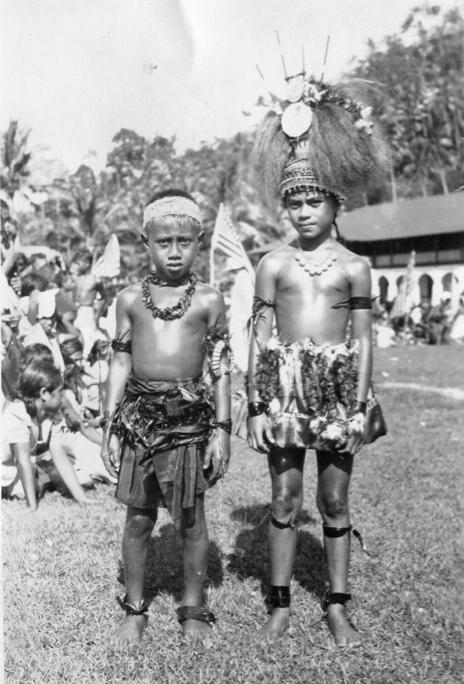
Samoan Islands History: World War II (1941-45)

Figure 1.--The Americans were as fascinated with the Samoans as the Samoans were with the Americans. This photograph shows Samoan children in traditional dress at some kind of school celebration. They and the other children in the background attended one of the schools founded by the Americans. Notice the American flag. The snapshot came from an album kept by an American sailor.
|
|
The Samoan Islands during World War II were one of several islands groups east of Australia targeted by the Japanese as part of their FS Operation. Ir consisted of the western islands (former German islands) administered by New Zealand and the eastern islands administered by the United States. The U.S. Navy used Pago Pago for a coaling and repair station (1878). It was known as the United States Naval Station Tutuila. As a result, at the time of the War thre were some limited naval facilities there. A Japanese submarine shelled Pago Pago Harbor (January 1942). We are not sure about the purpose of the shelling. Perhaps it was an act of bravado by the sub skipper. Or perhaps it was an effort to test out the American defenses. The Japanese were planning a much larger operation, but this would prove to be the only military action which occurred on the islands during the Pacific War. The Japanese wanted to severe the sea lanes between America and Australia to isolatete the country. Australia was large county, but had only a small population and manufacturing capacity. Heavy weapons, ships, and aircraft were imported from Britain and America. Isolating Australia was thus the first step in the eventual Japanese invasion and subjegation. FS was to be launched after the American carriers were engaged and destroyed in the Midway operation. This did not, however, go as Yammoto and Nagumo had planned. Samoa, like neigboring Fiji was after the loss of four of their first-line carriers at Midway (June 1942) beyond the reach of Japanese naval power. The lost Japanese carriers were slated to have been the core of the FS Operation strike force. Samoa after the U.S. Marine landings on Guadalcanal (August 1942) shifted from the piotential front line to an important rear area supply base while the still out-gunned Pacific Fleet and Imperial Navy slugged it out in the Solomons Campaign. Samoan society was still quite traditional at the onset of the War, It was a sleepy little South Pacifc island group still largely untouched by the outside world and modern technology. Samonans had few contacts with the wider world. The western islands had a few New Zealand administrators, missionaries, and western managers of the coconut platations. The American presence on the eastern islands was more substantial, but fairly limited. Tourism was virtually unknown. The influx of American servicemen along with vast numbers of vehicles and huge quantities of supplies had a profound impact on the islands.
CIH -- WW II

Navigate the CIH World War II Section:
[Return to the Main World War II Pacific islands page]
[Return to the Main Samoan history page]
[Return to the Main Samoan page]
[Return to the Main Oceania country history page]
[Biographies]
[Campaigns]
[Children]
[Countries]
[Deciding factors]
[Diplomacy]
[Geo-political crisis]
[Economics]
[Home front]
[Intelligence]
[POWs]
[Resistance]
[Race]
[Refugees]
[Technology]
[Bibliographies]
[Contributions]
[FAQs]
[Images]
[Links]
[Registration]
[Tools]
[Return to Main World War II page]
[Return to Main war essay page]
Created: 8:08 PM 4/22/2013
Last updated: 7:34 AM 5/2/2018



